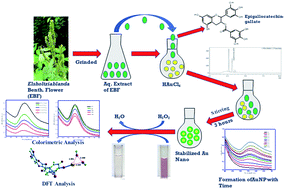A novel method for the rapid sensing of H2O2 using a colorimetric AuNP probe and its DFT study†
Abstract
Hydrogen peroxide (H2O2) has tremendous applications in industry, medicine and in our day-to-day lives. It is toxic to human health upon exposure at a high concentration. Therefore, a green and cost-effective sensing technique is greatly needed for the sensitive naked eye detection of peroxide. This study is mainly focused on the synthesis of Au nanoparticles (AuNPs) using an aqueous extract of Elsholtzia blanda, a flower that is widely available in the North Eastern part of India, the characterization of which was carried out using different analytical techniques. The bioactive molecule (epigallocatechin gallate) present in the aqueous extract was identified, isolated and confirmed through high-performance liquid chromatography-photodiode array, high-resolution mass spectrometry and nuclear magnetic resonance spectroscopy analysis which could be responsible for the reduction of Au3+ ions. By approaching this greener route, the synthesized nanomaterial was further used as a colorimetric probe for the detection of H2O2 and the degradation of AuNPs was observed. The limit of detection was found to be 0.7435 μM in the present work. The degradation of the AuNPs was found to be linearly dependent on peroxide concentration. Along with these results, kinetic studies were carried out by considering different effects to monitor the sensing speed of the AuNPs. The plausible mechanism of the work was supported by density functional theory study.



 Please wait while we load your content...
Please wait while we load your content...